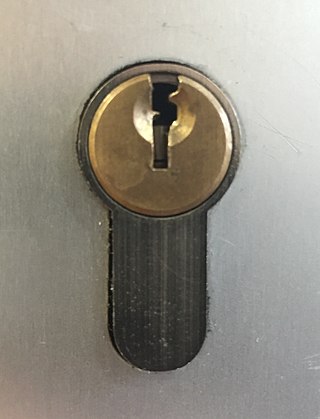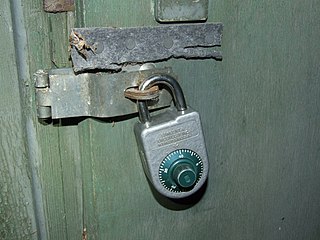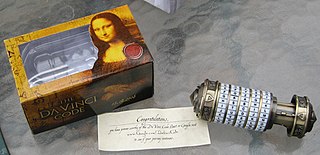
A rotary dial is a component of a telephone or a telephone switchboard that implements a signaling technology in telecommunications known as pulse dialing. It is used when initiating a telephone call to transmit the destination telephone number to a telephone exchange.

Linus Yale Jr. was an American mechanical engineer, manufacturer, and co-founder with millionaire Henry R. Towne of the Yale Lock Company, which became the premier manufacturer of locks in the United States. He was the country's leading expert on bank locks and its most important maker. By the early 20th century, about three-quarter of all banks in America used his bank locks. He is best remembered for his inventions of locks, especially the cylinder lock, and his basic lock design is still widely distributed today, and constitutes a majority of personal locks and safes.

The pin tumbler lock, also known as the Yale lock after the inventor of the modern version, is a lock mechanism that uses pins of varying lengths to prevent the lock from opening without the correct key.

A combination lock is a type of locking device in which a sequence of symbols, usually numbers, is used to open the lock. The sequence may be entered using a single rotating dial which interacts with several discs or cams, by using a set of several rotating discs with inscribed symbols which directly interact with the locking mechanism, or through an electronic or mechanical keypad. Types range from inexpensive three-digit luggage locks to high-security safes. Unlike ordinary padlocks, combination locks do not use keys.

A steno machine, stenotype machine, shorthand machine, stenograph or steno writer is a specialized chorded keyboard or typewriter used by stenographers for shorthand use. In order to pass the United States Registered Professional Reporter test, a trained court reporter or closed captioner must write speeds of approximately 180, 200, and 225 words per minute (wpm) at very high accuracy in the categories of literary, jury charge, and testimony, respectively. Some stenographers can reach 300 words per minute. The website of the California Official Court Reporters Association (COCRA) gives the official record for American English as 375 wpm.

A lock is a mechanical or electronic fastening device that is released by a physical object, by supplying secret information, by a combination thereof, or it may only be able to be opened from one side, such as a door chain.

Sargent & Greenleaf, Inc., more commonly known among Safe and Vault technician circles as S&G, is a U.S. company that manufactures combination locks, key-operated safe and safe deposit box locks, high security military padlocks, and associated equipment.

The word cryptex is a neologism coined by the author Dan Brown for his 2003 novel The Da Vinci Code, denoting a portable vault used to hide secret messages. It is a word formed from Greek κρυπτόςkryptós, "hidden, secret" and Latin codex; "an apt title for this device" since it uses "the science of cryptology to protect information written on the contained scroll or codex". The first physical cryptex was created by Justin Kirk Nevins in 2004.

A bank vault is a secure space where money, valuables, records, and documents are stored. It is intended to protect their contents from theft, unauthorized use, fire, natural disasters, and other threats, much like a safe. Unlike safes, vaults are an integral part of the building within which they are built, using armored walls and a tightly fashioned door closed with a complex lock.
Predictive text is an input technology used where one key or button represents many letters, such as on the physical numeric keypads of mobile phones and in accessibility technologies. Each key press results in a prediction rather than repeatedly sequencing through the same group of "letters" it represents, in the same, invariable order. Predictive text could allow for an entire word to be input by single keypress. Predictive text makes efficient use of fewer device keys to input writing into a text message, an e-mail, an address book, a calendar, and the like.

Padlocks are portable locks usually with a shackle that may be passed through an opening to prevent use, theft, vandalism or harm.

A sliding puzzle, sliding block puzzle, or sliding tile puzzle is a combination puzzle that challenges a player to slide pieces along certain routes to establish a certain end-configuration. The pieces to be moved may consist of simple shapes, or they may be imprinted with colours, patterns, sections of a larger picture, numbers, or letters.
A puzzle lock or puzzle padlock is a type of mechanical puzzle. It consists of a lock with unusual or hidden mechanics. Puzzle locks are reconfigurable mechanisms where the topological structure changes during the operation. Such locks are sometimes called trick locks, because there is a trick to opening them which needs to be found. Puzzle locks exist both with keys and without keys.

T9 is a predictive text technology for mobile phones, originally developed by Tegic Communications, now part of Nuance Communications. T9 stands for Text on 9 keys.

iTap is a predictive text technology developed for mobile phones, developed by Motorola employees as a competitor to T9. It was designed as a replacement for the old letter mappings on phones to help with word entry. This makes some of the modern mobile phones features like text messaging and note-taking easier.
Master Lock is an American company that develops padlocks, combination locks, safes, and related security products. Now a subsidiary of Fortune Brands Innovations, Master Lock Company LLC was formed in 1921 by locksmith-inventor Harry E. Soref and is headquartered in Oak Creek, Wisconsin. In 1970 the company was purchased by American Brands from Soref's heirs. American Brands was later renamed to Fortune Brands, which then split on October 3, 2011, to create the Fortune Brands Home & Security company and the beverages company Beam Inc..

Phonewords are mnemonic phrases represented as alphanumeric equivalents of a telephone number. In many countries, the digits on the telephone keypad also have letters assigned. By replacing the digits of a telephone number with the corresponding letters, it is sometimes possible to form a whole or partial word, an acronym, abbreviation, or some other alphanumeric combination.

A magnetic keyed lock or magnetic-coded lock is a locking mechanism whereby the key utilizes magnets as part of the locking and unlocking mechanism. Magnetic-coded locks encompass knob locks, cylinder locks, lever locks, and deadbolt locks as well as applications in other security devices.
Hotchkiss v. Greenwood, 52 U.S. 248 (1851), was a United States Supreme Court decision credited with introducing into United States patent law the concept of non-obviousness as a patentability requirement, as well as stating the applicable legal standard for determining its presence or absence in a claimed invention.

Current motor vehicle registrations in Chile are officially known as Placa Patente Única (PPU). This denomination was introduced when unifying the license plate registries at the national level, where each vehicle would carry a unique license plate in the country, in 1985.
















